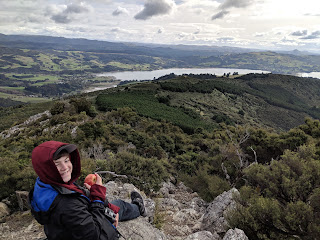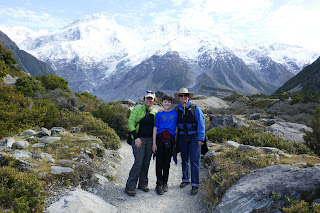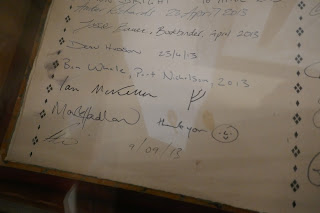 |
 |
| Fran relaxes in Auckland |
I believe this is a combination of working
less and being in nature much more. We aren’t more physically active here than
we are back home, but that activity has almost all been outdoors and is more a
part of our everyday lives, such as walking to the store. This has led to the
next change:
Our improved mental health is likely a
direct result from all the hiking we have been doing. We have decided that we
need to make getting out among the trees and water a priority when we get home.
New Zealand may be the most gorgeous place on the planet, but Colorado is a
close second. My already acute love for our planet almost hurts now- I am so
grateful that I have devoted much of my professional life to helping protect
Mother Earth and the diversity of life here.
All of my clothes can fit in one drawer
here. All other personal belongings fit into a suitcase. We heat with wood and
hang clothes to dry. Although we are eager to get our electric clothes dryer, central heating, and well-insulated house back, I hope to incorporate living with less “stuff” into our lives at home.
Living in New Zealand has shown us just how
much more rubbish (to use their word) Americans produce than Kiwis. Every place
we stayed had tiny trashcans, and it is not unusual for public parks to not
have any- and yet no trash problem. I believe that this is because: A) Kiwis
don’t eat out as much and when they do “take away” (fast food), it is in much
less packaging. No cups with lids and straws, for example.
B) Kiwis each much less processed food.
Fresh food has less packaging (if any), and
C) Most stores don’t give you a bag unless
you ask for one. Some grocery stores charge for plastic bags.
 |
| Fran and Jeremy embrace on the Driving Creek Railway (DCR) in Coromandel |
 |
| The view on a rainy day on the DCR |
5. We have become closer as a family
All of the together time that results from
doing homeschool and traveling for days on end at one go forces issues to
surface. It actually amazes us that we
are still enjoying each other’s company after these four months! We aren’t
perfect, but we are much better at voicing hurt feelings and frustrations in a
productive way and thus working through it and becoming closer as a result.
Jeremy still has to tolerate the PMS of two mothers (poor kid), but we can have
a sense of humor about it.
 |
| Jeremy gets a tutorial on the Erhu at the Dunedin Chinese Garden |
We see education differently now that we
have allowed the world to be Jeremy’s classroom. As my mother says, “You can’t
stop children from learning,” and we have seen what a sponge Jeremy is on this
trip. We are glad that he will be going to a school this fall that uses a
student-customized, project-focused pedagogy. This trip has given him loads of
ideas for “units” to study further when we are back.
Four months without our 10x lit magnifying
mirror has been a good thing. To my surprise, I have had fewer breakouts and
generally have better skin here than at home. Fran tweezes her eyebrows much less often. None of us has really been that concerned with our
appearance. Casual rules the day, and we only brought clothes we liked wearing.
Since no one around me seems to, I’ve not worn makeup of any type since the
first week here. I’ve also embraced the “Curly Girl Method” of hair care here,
which actually means that I haven’t combed or brushed my hair in four months.
No kidding.
 |
| Even if it's local and not organic, it's likely to be expensive |
Meat and produce are ridiculously expensive
here -$4 USD for one NZ-grown avocado, anyone?- but so delicious. Given my
sensitivity to corn, it has been wonderful living in a place where all dairy
and meat are from pasture-fed cows and the sweets and jams aren’t made with
corn-syrup; back home we’ll have to pay extra for this. The produce is so good, we are now much more willing to spend more on organic, fresh local food when we
get home. And we are now chocolate snobs!
Between hauling more weight around (see
chocolate, above) and climbing the hills and mountains everywhere, our quads are
pure steel! The increased strength in my legs has been great for my knee
problems, which have been nearly non-existent here, despite all of the
stair-climbing (I guess the physical therapist was right, dang it!). This
doesn’t stop Jeremy from complaining at some point during every hike, but we
hear “my legs are tired” much less.
I’ve always thought birds were sort of
cool, but after living in the land where birds rule the day, they have earned our respect and affection on a whole new level. Since they didn’t evolve with
mammals (including us), many native birds aren’t skittish around humans (see previous blog post for videos documenting this). Thus,
they seem much more friendly than birds in the US, and so also more endearing. Fran
and Jeremy’s favorite are the little blue penguins (that’s really what they are
called), and my favorite are the fan-tails, which follow you around when you
hike, making one feel like Snow White.
It is one thing to travel, quite another to
live in another place for several months. We learned that we can adapt: we can
call a new place home, make good friends, find new favorite foods, and generally
adjust to what feels strange and different. We know what it is to be the
stranger, at the mercy of the locals (and how very merciful and generous they
have been!). As we literally repeat each night during prayers, we are deeply,
deeply grateful to have been able to have this experience.
 |
| A view of Wellington from Mt. Victoria Lookout |
















































